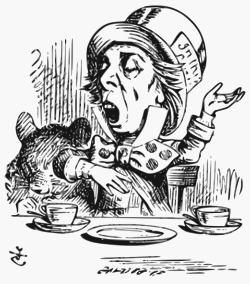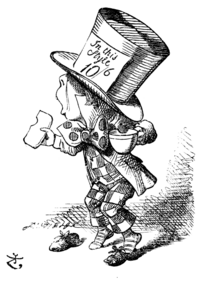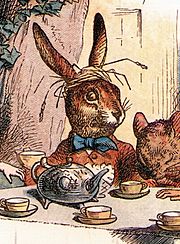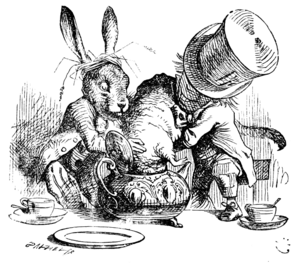Hatter (Alice's Adventures in Wonderland) facts for kids
Quick facts for kids The (Mad) Hatter |
|
|---|---|
| Alice character | |

The Hatter as depicted by John Tenniel, reciting his nonsensical poem, "Twinkle, Twinkle, Little Bat"
|
|
| First appearance | Alice's Adventures in Wonderland (1865) |
| Last appearance | Through the Looking-Glass (1871) |
| Created by | Lewis Carroll |
| Information | |
| Aliases | Hatter Mad Hatter |
| Species | Human |
| Gender | Male |
| Occupation | Messenger, hatter |
| Nationality | Wonderland, Looking-Glass Land |
The Hatter is a fun character from Lewis Carroll's famous books. He first appeared in Alice's Adventures in Wonderland in 1865. Later, he showed up in the 1871 sequel, Through the Looking-Glass.
Many people call him the Mad Hatter. However, Lewis Carroll himself never used that exact name. The saying "mad as a hatter" was actually around even before Carroll wrote his books. In Alice's Adventures in Wonderland, the Cheshire Cat says that both the Hatter and the March Hare are "mad."
The Hatter's Story
The Hatter in Wonderland
The Hatter first appears in Lewis Carroll's 1865 book Alice's Adventures in Wonderland. In "Chapter Seven – A Mad Tea-Party," Alice finds the Hatter having tea. He is with the March Hare and the Dormouse.
The Hatter tells Alice that they are always having tea. This is because he once tried to sing for the Queen of Hearts. She was very angry and said he "murdered the time." As a result, Time (who the Hatter calls "he") stopped moving for him. This means the Hatter is stuck at 6:00 pm forever.
At the tea party, the Hatter often switches seats. He makes quick, personal comments. He also asks riddles that have no answer. He recites silly poems too. All these things eventually make Alice leave.
The Hatter appears again in "Chapter Eleven – Who Stole the Tarts?". He is a witness at the Knave of Hearts' trial. The Queen seems to remember him as the singer she was angry with. The King of Hearts warns him not to be nervous.
The Hatter in Looking-Glass Land
The Hatter also makes a short appearance in Carroll's 1871 book Through the Looking-Glass. In this book, he is called "Hatta." He is in trouble with the law again.
However, the White Queen explains something strange. In her world, people are often punished before they even do a crime. Sometimes, they don't commit a crime at all!
Hatta is also one of the White King's messengers. The March Hare, called "Haigha," is another messenger. Sir John Tenniel's drawing shows Hatta sipping from a teacup. This is just like he did in the first book. Alice does not say if Hatta is the same Hatter from her earlier dream.
What Makes the Hatter Special

Why "Mad as a Hatter"?
The phrase "mad as a hatter" was common in the 1800s. This was because of how hats were made back then. Hat makers used a chemical called mercury. Working with mercury for a long time could make people sick. It could cause problems with their brain and nerves. Symptoms included slurred speech, memory loss, and shaking.
Lewis Carroll knew about these health issues. His uncle, Robert Wilfred Skeffington Lutwidge, was a Lunacy Commissioner. He visited places where people with mental illnesses lived. These places sometimes held tea parties for their patients. This might have given Carroll ideas for the Mad Tea-Party.
The Hatter's Look
Carroll doesn't describe the Hatter's hat in detail. But John Tenniel's famous drawings show him wearing a tall top hat. The hat has a band that says "In this style 10/6."
In The Nursery "Alice", Carroll explains this. The numbers 10 and 6 mean the hat cost ten shillings and six pence. This was the price in old British money.
The Hatter's Friends

The Cheshire Cat first calls the Hatter and his friend, the March Hare, "both mad." This happens in "Pig and Pepper," the sixth chapter of Alice's Adventures in Wonderland. Alice asks what kind of people live nearby. The cat replies, "in that direction lives a Hatter, and in that direction, lives a March Hare. Visit either you like: they're both mad!"
The Hatter and March Hare then appear in the next chapter, "A Mad Tea-Party."
Lewis Carroll grew up in Stockport, where hat making was a big business. Hatters often seemed confused or unwell. Many died young because of mercury poisoning. However, the Hatter in the book doesn't show all the typical signs of mercury poisoning. These signs include being very shy or losing confidence.
Was the Hatter a Real Person?
Some people believe the Hatter was inspired by a real person. This person was Theophilus Carter, a furniture dealer. Carter was known for standing in his shop doorway wearing a top hat. People called him the "Mad Hatter."
It's said that John Tenniel even visited Oxford to sketch him for the illustrations. However, there is no proof of this in Carroll's letters or diaries.
The Hatter's Famous Riddle
In the chapter "A Mad Tea Party," the Hatter asks a well-known riddle: "Why is a raven like a writing desk?" Alice tries to guess the answer but gives up. The Hatter then admits, "I haven't the slightest idea!"
Carroll originally meant for the riddle to have no answer. But many readers asked for one. So, he and others, including puzzle expert Sam Loyd, suggested possible answers. In 1896, Carroll wrote:
People have asked me so often if there's an answer to the Hatter's riddle. So, I might as well write down what seems like a good answer: "because it can produce a few notes, though they are very flat; and it is nevar put with the wrong end in front!" But this was just an idea I had later. The riddle was first made without any answer at all.
Other people also came up with answers:
- Sam Loyd suggested, "because Poe wrote on both." This refers to Poe's poem The Raven.
- Another idea was, "because the notes for which they are noted are not noted for being musical notes."
- In 2017, Rick Hosburn suggested: "Because one is a crow with a bill, while the other is a bureau with a quill!" The RSPB says a raven "is all black with a large bill."
- Author Stephen King gave a different answer in his 1977 novel The Shining. A character hears a voice say: "Why is a raven like a writing desk? The higher the fewer, of course! Have another cup of tea!"
See also
 In Spanish: El Sombrerero para niños
In Spanish: El Sombrerero para niños


